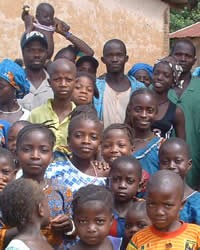The Lele are a small group that belong to the Mande people cluster. They are related to the Maninka, also known as the Malinke people group, but speak a distinct language and have much in common with other forest peoples in the region. The most closely related people group in Guinea is the Kuranko, also one of the Mande peoples related to Maninka. Despite being a small group, the Lele speak roughly eight different dialects of the Lele language. They are in Guinea, on the western coast of Africa. Most of their history is not recorded, because they pass down information by oral tradition.
The Lele people are in Upper and Middle Guinea. Middle Guinea is filled with mountains, along with many rivers that run through them. This is where the Niger, Senegal and Gambia rivers begin, giving way to the prosperous farmlands surrounding them. Upper Guinea includes more savannas and plains than mountains. This is where most of the Lele are found, in smaller agricultural settlements in the river valleys.
In the Lele culture, men are seen as the head of the lineage. Houses of men from the same clan are usually the ones in positions of authority in each village. The Lele have a chief, but he does not have any political power.
Most of the Lele are primarily agriculturalists, with rice, palm nuts, peanuts and sweet potatoes being the most common crops. Poor transportation systems and harsh weather in rainy season often hinder the movement of materials and raise their costs. Both Lele men and women participate in the farming chores. Men do much of the work to clear land and break up soil. Women help with planting, weeding and harvesting. Men spend much of their time in the fields or hunting. Women usually complete more time-consuming chores in the home such as hauling water, cooking, cleaning and child rearing. Traditionally, a Lele women is part of a polygamous marriage and has about five children, with at least one dying in their early years.
The Lele emphasize manners among their children, believing that they represent the difference between man and beast. It is uncommon for a Lele child to contradict an adult. Children are raised by their elders in addition to their parents. It is socially acceptable for family, friends and people in the village to reprimand a child who misbehaves.
The two main belief systems of the Lele are Islam and ethnic religions. Five percent of the Lele are Christians, but a little less than two percent are evangelical. 80% of the population would claim to be Muslim, but many would mix in traditional animistic practices. About 15% of Leles practice only animism. The observance of Muslim holidays and regular prayers are a common occurrence among the Lele. However, Lele women do not generally live in seclusion or wear full coverings as they do in some other Muslim contexts. The Lele's animistic practices have been incorporated into their practice of Islam. Each Lele community usually has a male and a female religious leader. They oversee religious rituals, including but not limited to circumcision. Female circumcision is still practiced widely among the Lele as part of initiation ceremonies.
The Lele people lack clean water and adequate medical facilities. Christian workers can help them with these needs.
Pray for the Holy Spirit to guide the ongoing work being done to translate the Bible into Lele.
Pray also for the team doing literacy work and creating reading materials.
Pray that God will inspire people to create more audio clips of the Bible in Lele and that this will lead to a church planting movement.
Pray that God will bring an end to female circumcision (FGM) among the Lele.
Pray that existing churches will reach out to the Lele people in a culturally appropriate way.
Pray that Lele children will have more opportunities to attend school and to become literate.
Pray for a movement to Christ among the Lele people.
Scripture Prayers for the Lele in Guinea.
| Profile Source: Joshua Project |

























